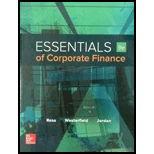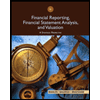
Essentials of Corporate Finance (Mcgraw-hill/Irwin Series in Finance, Insurance, and Real Estate)
9th Edition
ISBN: 9781259277214
Author: Stephen A. Ross Franco Modigliani Professor of Financial Economics Professor, Randolph W Westerfield Robert R. Dockson Deans Chair in Bus. Admin., Bradford D Jordan Professor
Publisher: McGraw-Hill Education
expand_more
expand_more
format_list_bulleted
Question
Chapter 14, Problem 12QP
a)
Summary Introduction
To determine: The effects of share repurchase and cash dividend on the price per share of the stock and shareholders’ wealth.
Introduction:
Share repurchase:
A company that buys its own stock through the exchange of cash is termed as a stock repurchase. It is like the buyback of shares.
Cash dividend:
Cash dividend is the dividend which is payable to the shareholders on distribution of certain amount of company’s earnings.
b)
Summary Introduction
To determine: The effects on the company’s EPS (Earnings per Share) and PE ratio (Price Earnings ratio).
c)
Summary Introduction
To discuss: Whether the share repurchase or cash dividend is recommended.
Expert Solution & Answer
Want to see the full answer?
Check out a sample textbook solution
Students have asked these similar questions
Ned's Co. has an average collection period of 45 days and an operating cycle of 130 days. It has a policy of keeping at least $10 on hand as a minimum cash balance, and has a beginning cash balance for the first quarter of $20. Beginning receivables for the quarter amount to $35. Sales for the first and second quarters are expected to be $110 and $125, respectively, while purchases amount to 80% of the next quarter's forecast sales. The accounts payable period is 90 days. What are the cash disbursements for the first quarter?
Question 4 options:
$92
$88
$76
$100
$110
Liberal credit terms for customers is associated with a restrictive short-term financial policy.
Question 3 options:
True
False
An accounts payable period decrease would increase the length of a firm's cash cycle. Consider each in isolation.
Question 6 options:
True
False
Chapter 14 Solutions
Essentials of Corporate Finance (Mcgraw-hill/Irwin Series in Finance, Insurance, and Real Estate)
Ch. 14.1 - Prob. 14.1ACQCh. 14.1 - Prob. 14.1BCQCh. 14.1 - Prob. 14.1CCQCh. 14.2 - Prob. 14.2ACQCh. 14.2 - Prob. 14.2BCQCh. 14.2 - Prob. 14.2CCQCh. 14.3 - Prob. 14.3ACQCh. 14.3 - Prob. 14.3BCQCh. 14.5 - Prob. 14.5ACQCh. 14.5 - Prob. 14.5BCQ
Ch. 14 - What are the forms of cash dividends?Ch. 14 - Prob. 14.2CCh. 14 - Prob. 14.3CCh. 14 - Prob. 14.4CCh. 14 - Prob. 14.5CCh. 14 - Prob. 1CTCRCh. 14 - Prob. 2CTCRCh. 14 - Prob. 3CTCRCh. 14 - Prob. 4CTCRCh. 14 - Prob. 5CTCRCh. 14 - Prob. 6CTCRCh. 14 - Prob. 7CTCRCh. 14 - Prob. 8CTCRCh. 14 - Dividend Policy. During 2014, 207 companies went...Ch. 14 - Prob. 10CTCRCh. 14 - Prob. 1QPCh. 14 - Prob. 2QPCh. 14 - Prob. 3QPCh. 14 - Prob. 4QPCh. 14 - Prob. 5QPCh. 14 - Stock Splits and Stock Dividends. Bermuda Triangle...Ch. 14 - Prob. 7QPCh. 14 - Prob. 8QPCh. 14 - Prob. 9QPCh. 14 - Prob. 10QPCh. 14 - Stock Splits. In the previous problem, suppose the...Ch. 14 - Prob. 12QPCh. 14 - Dividend Policy. The Quick Buck Company is an...Ch. 14 - Expected Return, Dividends, and Taxes. The Gecko...Ch. 14 - Prob. 15QPCh. 14 - Prob. 1CCCh. 14 - Prob. 2CCCh. 14 - Prob. 3CCCh. 14 - Prob. 4CCCh. 14 - Prob. 5CCCh. 14 - Prob. 6CC
Knowledge Booster
Learn more about
Need a deep-dive on the concept behind this application? Look no further. Learn more about this topic, finance and related others by exploring similar questions and additional content below.Similar questions
- Which of the following is the best definition of cash budget? Question 10 options: Costs that rise with increases in the level of investment in current assets. A forecast of cash receipts and disbursements for the next planning period. A secured short-term loan that involves either the assignment or factoring of the receivable. The time between sale of inventory and collection of the receivable. The time between receipt of inventory and payment for it.arrow_forwardShort-term financial decisions are typically defined to include cash inflows and outflows that occur within __ year(s) or less. Question 9 options: Four Two Three Five Onearrow_forwardA national firm has sales of $575,000 and cost of goods sold of $368,000. At the beginning of the year, the inventory was $42,000. At the end of the year, the inventory balance was $45,000. What is the inventory turnover rate? Question 8 options: 8.46 times 13.22 times 43.14 times 12.78 times 28.56 timesarrow_forward
- The formula (Cash cycle + accounts payable period) correctly defines the operating cycle. Question 7 options: False Truearrow_forwardAn accounts payable period decrease would increase the length of a firm's cash cycle. Consider each in isolation. Question 6 options: True Falsearrow_forwardWhich of the following issues is/are NOT considered a part of short-term finance? Question 5 options: The amount of credit that should be extended to customers The firm determining whether to issue commercial paper or obtain a bank loan The amount of the firms current income that should be paid out as dividends The amount the firm should borrow short-term A reasonable level of cash for the firm to maintainarrow_forward
- Liberal credit terms for customers is associated with a restrictive short-term financial policy. Question 3 options: True Falsearrow_forwardAn increase in fixed assets is a source of cash. Question 2 options: True Falsearrow_forwardIf the initial current ratio for a firm is greater than one, then using cash to purchase marketable securities will decrease net working capital. True or falsearrow_forward
- what is going to be the value of American put option that expires in one year modeled with a binomial tree of 3 months step with year to expiry? assume the underlying is oil future with RF of 5% and vol of oil is 30%. Strike is 70 and price is 60 of oil. 13.68 13.44 13.01arrow_forwardhello tutor need step by step approach.arrow_forwardNeed step by step approach hrlparrow_forward
arrow_back_ios
SEE MORE QUESTIONS
arrow_forward_ios
Recommended textbooks for you
 EBK CONTEMPORARY FINANCIAL MANAGEMENTFinanceISBN:9781337514835Author:MOYERPublisher:CENGAGE LEARNING - CONSIGNMENT
EBK CONTEMPORARY FINANCIAL MANAGEMENTFinanceISBN:9781337514835Author:MOYERPublisher:CENGAGE LEARNING - CONSIGNMENT Financial Reporting, Financial Statement Analysis...FinanceISBN:9781285190907Author:James M. Wahlen, Stephen P. Baginski, Mark BradshawPublisher:Cengage Learning
Financial Reporting, Financial Statement Analysis...FinanceISBN:9781285190907Author:James M. Wahlen, Stephen P. Baginski, Mark BradshawPublisher:Cengage Learning

EBK CONTEMPORARY FINANCIAL MANAGEMENT
Finance
ISBN:9781337514835
Author:MOYER
Publisher:CENGAGE LEARNING - CONSIGNMENT

Financial Reporting, Financial Statement Analysis...
Finance
ISBN:9781285190907
Author:James M. Wahlen, Stephen P. Baginski, Mark Bradshaw
Publisher:Cengage Learning
What Are Stock Buybacks and Why Are They Controversial?; Author: TD Ameritrade;https://www.youtube.com/watch?v=2O4bmcliaog;License: Standard youtube license